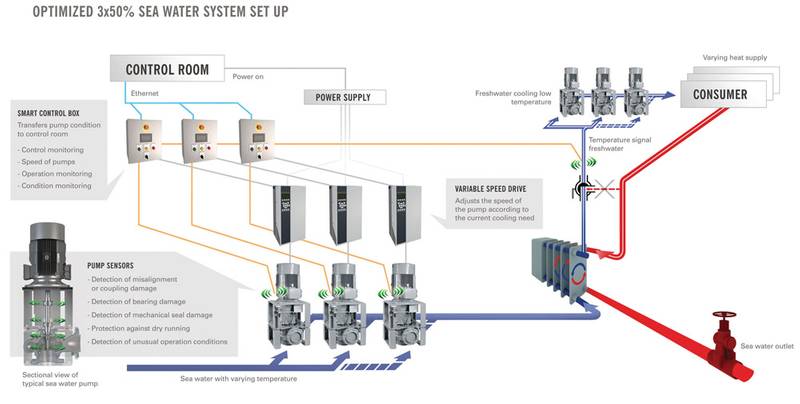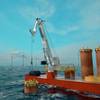Tech Profile: Colfax CM-1000
“Smart Tech” for Efficient Sea Water Cooling Pumps
As ship owners scrupulously search for means to cut costs by saving energy, Colfax offers the CM-1000 Series, a smart technology which helps to monitor and control sea water cooling system pumps. It can help to save more money than you think.
Colfax introduced earlier this year the CM-1000 Series, a smart technology designed to help monitor and control sea water cooling system pumps in a manner that senses water temperature and speed to optimize the pump use.
Savings for the shipowner come not only via fuel used to power the pumps (in some cases, up to 80% in fuel consumption reduction and 50% in maintenance cost reduction have been recorded), but also the benefit is an appreciable reduction of wear and tear on pump parts and maintenance.
“Twenty-five percent of energy consumption of auxiliary equipment is via pumps, and most of that is for seawater cooling pumps,” said Christian Martin, Director Product Management, Colfax Fluid Handling Commercial Marine. “So this was a natural area of concern and study.”
As he explained, seawater cooling pumps are generally designed for operation in the warmest waters with the ship moving at the fastest speed. But in reality, the operation spectrum is in cooler waters at slower speeds, meaning that the seawater cooling pumps can over perform and burn energy unnecessarily. Accurate condition monitoring allows the pumps to operate based on real-world conditions, burning only the energy needed.
The Solution: CM-1000
Colfax Fluid Handling earlier this year introduced the Colfax Fluid Handling Smart Technology CM-1000 Series, which is touted as an intelligent sea water cooling system controller designed to maximize shipboard pumping efficiency while lowering operating and maintenance costs and maximizing uptime.
CM-1000 can be applied in both newbuilds or retrofits of existing sea water cooling systems, and according to the manufacturer it is designed to work effectively with both 2 x 100% and 3 x 50% pumping configurations. The CM-1000 offers:
• Variable Speed Operation that adjusts and lowers motor and pump speed, providing energy savings between 40 and 80% and reducing the loads to provide longer equipment life and minimize maintenance; this replaces the traditional system design that features continuously - running pumps at full speed for worst-case conditions (32 degrees C sea water, full load of all equipment, plus a bypass control)
• Condition Monitoring that detects potential wear and/or fault conditions such as bearing damage, misalignment or coupling damage, mechanical seal damage and dry running, to help to prevent catastrophic breakdown
• Operation Monitoring that extends mean time between failures (MTBF) by avoiding part load and overload operation to decrease bearing load and cavitation occurrences and to provide safe operation and consistent pump performance.
“Lowering revolution speed by 20% is designed to reduce flow by 20% and effectively cut energy consumption by 50%,” said Martin. “Reduced fuel use means a greener, more sustainable vessel. Reducing overall loads enhances the life of equipment; that means reduced maintenance and an enhanced return on equipment investment.”
According to the company, which offers a potential savings calculator directly on its website (see details at end of this story), return on investment in the CM-1000 is generally one year.
In parallel to its primary task, the CM - 1000 is designed to provide constant and reliable cooling to all shipboard consumers of energy, such as the main engine, generator and auxiliary equipment, even at sea water temperatures up to 32 degrees C. As temperature conditions change on the freshwater side, the system reacts by varying the speed of the electric motors of sea water pumps accordingly, using only the speed – and energy – required to provide optimal cooling conditions. This effectively reduces hydraulic loads and enhances the lifetime of the motors, pumps and related equipment through reduced usage and wear.
The CM - 1000 Series uses sensors to monitor equipment and the operation conditions of each specific pump. Then the CM - 1000 exchanges data through an Ethernet and provides real-time information and status indicators to the control room.
smart.colfaxcorp.com/CM1000
Case Study: China Navigation
When China Navigation Company was planning for a new series of eight 31,000 dwt “S” Class multipurpose vessels, energy savings and sustainability were high on its list. Built at the Zhejiang Ouhua Shipyard, Zhoushan, China, and designed for containers, breakbulk and bulk cargo, the first of the vessels, the MV Shansi, launched in mid-April 2013 and will be part of Swire Shipping’s multipurpose liner trade that link north, east and southeast Asia to key markets in Australia, New Zealand and island nations of the South Pacific. The new “S” Class vessels are designed for high speed cargo handling and the versatility to carry a wide range of cargo types. The new “S” Class vessels are designed for best-in-class environmental initiatives, including fuel efficiency and emission reduction to deliver the lowest carbon footprint possible from operations, including
• Reusing exhaust gases from the main engine and generators
• Hull form that combines high cargo capacity and low fuel consumption
• Wake ducts to improve fuel efficiency cargo cranes that use 40 to 50% power of traditional cranes.
One specific area identified for energy savings as well as operational and maintenance savings was the sea water cooling system, for which it selected the Colfax Fluid Handling Smart Technology CM-100 Series.
(As published in the September 2013 edition of Maritime Reporter & Engineering News - www.marinelink.com)

















